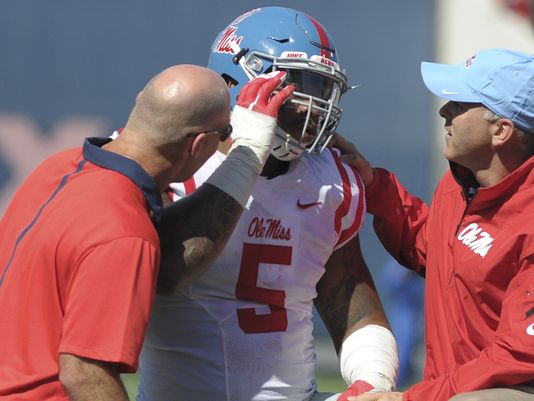
After suffering a concussion Oct. 17, Ole Miss defensive tackle Robert Nkemdiche needed six days to complete the team’s protocol for returning from the injury.
However, the junior still missed the Rebels’ game last Saturday against Texas A&M, one day after being cleared, because he experienced symptoms that morning. Nkemdiche is expected to return for Saturday’s 11 a.m. road game against Auburn.
While incidents such as Nkemdiche’s aren’t out of the ordinary, Shannon Singletary, Ole Miss senior associate athletic director of sports medicine/strength and conditioning, said while speaking in general, they do illustrate the difficulty of treating an athlete who has received a concussion.
“It can be very similar to delayed onset muscle soreness,” Singletary said. “You lift weights really hard on Tuesday, you don’t get really sore until Thursday or Friday. Sometimes they go through that contact practice, no symptoms all along, they’ve done great all week.
“It may take 24 hours (for a reoccurrence of symptoms). ‘You know, I’m not recovering as quick as I would have normally.’ You’ve got to listen to that.”
All NCAA teams follow the same protocol, which is comprised of objective and subjective tests over multiple days, to treat athletes returning from a concussion.
A football player who suffers one in a game Saturday must wait until he is symptom-free, usually about one or two days, to begin the concussion treatment.
The first step is the ImPACT exam, which has around 30 questions and takes about 30 minutes to complete. The computer-based test measures memory and reaction time, and players can pass only if their results are comparable to the baseline score they received when they took the test following their arrival on campus as a freshman or a transfer student.
Once cleared, they complete an exercise such as riding a stationary bicycle or using a step machine in an effort to raise their heart rate to see if symptoms return. If none do, athletic trainers raise the intensity by making the athlete sprint or lift weights.
Athletic trainers rely upon athletes being honest about a reoccurrence of symptoms that can’t be diagnosed, such as blurred vision. Others, such as sensitivity to light, can be spotted.
To help combat what Singletary calls the “tough guy” or “tough coach” aspect of athletes trying to rush back, they undergo an objective test for balance, which includes three 20-second parts: standing with feet together; standing on one leg with the other lifted and bent; and standing with one foot in front of the other, all with the athlete’s eyes closed and hands on his or her hips.
Points are deducted each time the athlete sways out of the starting position. His or her score is compared to the baseline test the person takes every year.
If there are no setbacks, players return completely to practice usually by Thursday, five days after their concussion. If they experience symptoms again, they repeat the step one day later.
Athletic trainers don’t stop working with players until determining they’re fine following their first competition after being cleared, usually a week following the concussion.
An important part of the process, Singletary said, is following up each day with athletes with questions such as what was it like when stepping outside that day or how did reading go in class. These test the patient’s sensitivity to light and ability to concentrate.
Head football athletic trainer Pat Jernigan stressed the importance of athletes being knowledgeable about concussions. Ole Miss athletes sign a form stating they will take responsibility for reporting injuries or illnesses and are given information about concussions.
“Back in the ’70s, ’80s and probably early ’90s, it was, ‘You’re fine to go back,’” Jernigan said. “It seems like it always take a generation for all that to catch up. Kids are more apt to say, ‘Hey, something happened, I’m not feeling right’ than to not say anything.
“It’s not your ankle. This is your brain. You have one of them, so you got to take care of it.”
Contact Daniel Paulling at dpaulling@jackson.gannett.com. Follow @DanielPaulling on Twitter.
ORIGINAL ARTICLE:
http://www.clarionledger.com/story/sports/college/ole-miss/2015/10/29/nkemdiches-concussion-shows-difficulty-treatment/74824400/